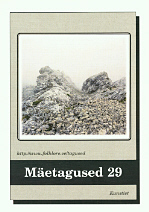Katse mõista keraamikut
An Attempt to Understand a Ceramist
Author(s): Piret ÕunapuuSubject(s): Fine Arts / Performing Arts
Published by: Eesti Kirjandusmuuseum
Summary/Abstract: Ceramics has never had particular significance in Estonian folk art. Traditionally, the Estonians expressed their creativity by cutting wood or forging iron. Thus, we cannot speak about popular tradition of folk ceramics, as it is a relatively recent field of art or consumer art. Throughout times, Maanus Mikkel's creation has possessed the underlying quality that enables to call it ethnic art, regardless of the stylistic changes it has undergone. His works create the sense of a certain paradigm. A major part of Mikkel's creation, regardless of the technique, appears expressive, robust. Virility of his art is emphasised by the use of rough clay and often also irregular form. Although being primordially Ugric, the theme has not a single speck of grotesque in it. Figures are blown bigger, and have nothing in them indicative of the usual reticence of the Estonians. Most of the works are serious; others express a small hint of tongue-in-cheek irony. It is not very common to ceramic pottery to have animate creatures depicted on them. Mikkel's creation almost always has clearly animate representations, though sometimes of unknown origin, including, for example, flying dragons as well as the tentative category of prehistoric animals. The figures, which sometimes disappear from the pottery only to re-emerge later, represent creatures of the times before the Ice Age. Of known species the most popular representations are that of bat and fish, even though some fish seem to favour flying, too. Some earlier works are reminiscent of prehistoric cave art, but this style has become considerably rarer. The new figures that have appeared in his work are humans - men and women. Love in the inane. Mikkel's earlier darker tone has become considerably brighter, his lines more round and fluent. Fortunately, the primordial fossils have not altogether disappeared in Mikkel's work; thus his already versatile world has acquired a new dimension. And who knows what course his art will take in the future.
Journal: Mäetagused. Hüperajakiri
- Issue Year: 2005
- Issue No: 29
- Page Range: 175-190
- Page Count: 16
- Language: Estonian

